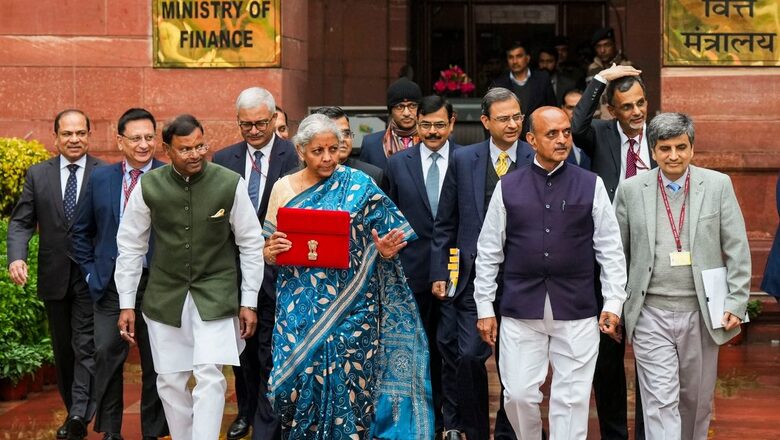
views
In part I of my piece on this year’s interim budget, I talked about how Finance Minister Nirmala Sitharaman has kept the budget story short, simple and to the point. Her 56-minute budget speech is her shortest and yet, her boldest and that too without any political grandstanding and revdis. In this regard, the budget is in sharp contrast to the 2020 interim budget of the Modi government when it used the occasion to provide significant tax concessions and fiscal handouts.
Much More in July
Talking of the interim budget, Prime Minister Narendra Modi was rather categorical that after this trailer of the mandatory votes on accounts, the real thing will come in July when his government presents the full-year budget for the third term. So confident is the government about its return that the PM said, “This budget carries the confidence of continuity and will empower all pillars of developed India – youth, poor, women and farmers.”
The prime minister presupposes the return of his government for another term to weave together the dream of a Viksit Bharat by 2047 and the budget of FM Sitharaman, instead of talking of any annual allocation, provides for a five-year agenda and pointers of the likely action points.
In Part II, I focus on the social infrastructure, social inclusion and social justice orientation.
Inclusive Development
A key plank of FM Sitharaman’s budget speech has been the new development philosophy of the Modi government, duly covering all elements of inclusivity, including but not limited to social inclusivity through coverage of all the strata of society as well as the geographical inclusivity through the development of all regions of the country. And to prove her point, and rightly so, the finance minister spoke of the focus on housing for all, Har Ghar Jal, electricity for all, cooking gas for all, bank accounts and financial services for all schemes and free foodgrain schemes for 80 crore population. FM also emphasised that the above focus on inclusivity and attainment of the key targets have been achieved in record time.
When the finance minister talked of the above and bringing 25 crore poor out of multidimensional poverty, she called it “an effective and necessary governance model.” While prima facie this author concurs with the numbers spelt out by the finance minister, he is also aware consciously that the task of the next full budget and the new government in the coming years is cut out owing to the following-
One, despite an appreciable reduction in multidimensional poverty in recent years, India remains home to the world’s one of the largest congregations of absolute poor living on per capita income of less than $2.1 per day.
Two, while the above numbers provided in the budget speech and budget documents are laudable, there exist serious inter-regional imbalances on the sustainability of the gains of all the schemes, be it Har Ghar Jal, electricity for all or other such schemes.
Three, before India becomes developed, it must become less corrupt. Indubitably, with digital transformation and digital inclusion, the transfer of benefits under the varied government schemes to the beneficiaries has become much more transparent than it used to be. Nonetheless, the problem with us is that we keep reinventing the wheel of corruption. As such, even if we dispute the relative ranking, India slipping eight places to rank 93 from 85 out of 180 countries in the Corruption Perceptions Index 2023 of transparency international rating does not bode well for the country. And the task of the upcoming government is cut out. When it comes to corruption, there is no middle path – it must be curbed forthwith, and ruthlessly so.
Four, rural poverty needs heavy lifting. Agriculture is at a subsistence level; it contributes 15 per cent to the economy but more than 50 per cent of the population is dependent on it with substantive underemployment in the sector. This is one area where the track record of the past ten years requires to be enhanced multi-fold. In this connection, one salutary focus of the budget is on Lakhpati Didis particularly the target of increasing their number from 2 crore to 3 crores.
Housing Poor and Not So Poor
Of all the social sector schemes, the one which really accredits it well is the near completion of three crore affordable houses for the poor, in the rural area under Prime Minister Awas Yojana (Grameen) and that too majorly in single or joint name of the woman of the house. The most singular pointer in the interim budget is the announcement of two crore more rural houses under the scheme to be completed in the next five years. When it comes to the poor, nothing is more empowering than them, that too woman, having a pucca roof above their head, the one which they own.
Though the full contour of the scheme has not yet been provided, the interim budget also provides for a housing scheme for the middle class to buy and build their own houses and the scheme is to benefit those who are staying in rented houses, chawls and illegal societies. Once the full contour of the scheme is provided, it will be a game-changer.
Education and Skilling
As regards education the budget talks of the creation of five IITs, 15 AIIMS and 290 new universities in the last ten years. It also talks of training 1.4 crore youth under the Skill India Mission. But it provides no pathway to meet the education excellence of higher education and meeting the educational deficit of primary and secondary education. It is also conspicuously silent on the massive need for skilling to make India’s youth employable. And the problem is truly gigantic in nature because by 2030 the population of youth in the country is likely to hit 1 billion.
If India, the most populous country of the world now (with the Chinese population shrinking again for the second time in a row in 2023 by over two million), must become Viksit by 2023 and if it must reap the benefits of its population dividend, it requires a fundamental change in the education system across the tiers, regions and states and rural and urban divide. For Bharat to be Viksit, it must be educated first. And the type of education that is needed is not like that of past or even present, the entire Indian education ecosystem must be reimagined.
What the last ten years of the Modi government have done to its roads and highways in quantitative terms, the next ten years of governance in India must do that to its education, both in quantitative and qualitative aspects. And the journey must begin from the villages of the poorest states where neither the schools have roofs, nor they have teachers who can teach. The transformative change calls for not only an exponential increase in the educational outlay but altogether a paradigm shift. Digital empowerment of the nation has a big role to play.
Health
The interim budget provides for four specific interventions in the health sector. One, encouraging cervical cancer vaccination for girls (9-14 years); two, expediting Saksham Anganwadi and Poshan 2.0 for improved nutrition delivery, early childhood care and development; three, rolling out of U-WIN platform for immunisation efforts of Mission Indradhanush and four, the extension of the health cover under Ayushman Bharat scheme to all ASHA, Anganwadi workers and helpers.
Above are laudable objectives. But they are just tinkering at the surface. One cannot and must not expect a miracle cure in an interim budget for the substantive ailment that the Indian healthcare system is currently mired in. Nonetheless, this must be the singular focus area of the governance in the next term. The time for platitudes and mere good intentions is over. It is heavy lifting time for the physical and mental health of residents of the Indian nation and the transformation required is across primary, secondary and tertiary health sectors.
The entire medicare system needs to be reimagined. As per the last available data, 63 per cent of total medicare expenses in India are out of pocket (OOP) of the family. This is one of the highest in the world. But this is not all. In states like UP and Bihar, OOP constitutes more than 75 per cent of total healthcare expenses. The biggest sufferers are poor and medicare OOP is the most common reason for sending families back to poverty. Then there are structural issues, infrastructural issues, availability of manpower issues and myriad other issues related to healthcare.
If there is one area in which I was most intently looking for guidance for the future in the interim budget, it was the pathways for robust physical and mental healthcare in both urban and rural areas of the country in primary, secondary and tertiary healthcare. India needs a 20-year roadmap, with an annual achievable target to reboot and reimagine healthcare.
The author is Multidisciplinary Thought Leader with Action Bias and India Based International Impact Consultant. He works as President Advisory Services of Consulting Company BARSYL. Views expressed in the above piece are personal and solely those of the author. They do not necessarily reflect News18’s views.


















Comments
0 comment